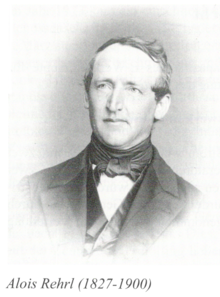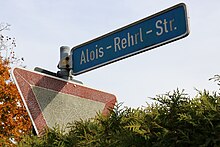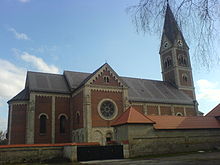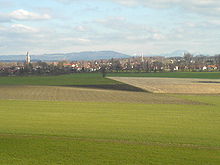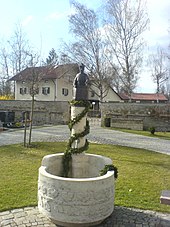Fridolfing
| coat of arms | Germany map | |
|---|---|---|
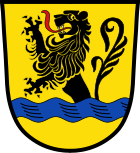
|
Coordinates: 48 ° 0 ' N , 12 ° 50' E |
|
| Basic data | ||
| State : | Bavaria | |
| Administrative region : | Upper Bavaria | |
| County : | Traunstein | |
| Height : | 388 m above sea level NHN | |
| Area : | 44.23 km 2 | |
| Residents: | 4401 (Dec. 31, 2019) | |
| Population density : | 99 inhabitants per km 2 | |
| Postal code : | 83413 | |
| Area code : | 08684 | |
| License plate : | TS, LF | |
| Community key : | 09 1 89 118 | |
| Community structure: | 66 districts | |
| Address of the municipal administration: |
Hadrianstrasse 28 83413 Fridolfing |
|
| Website : | ||
| Mayor : | Johann Schild ( SPD ) | |
| Location of the municipality of Fridolfing in the Traunstein district | ||
Fridolfing is a municipality in the Upper Bavarian district of Traunstein and is located in the Salzach Valley .
Pietling and Götzing are among the 66 parts of the municipality . The community is a member of the Euregio Salzburg - Berchtesgadener Land - Traunstein .
In addition to Tittmoning , Kirchanschöring and Taching am See , Fridolfing is part of the Salzachtal intermunicipal cooperation. This is one of 21 nationwide model regions that were selected by the Federal Ministry of Transport, Building and Urban Development (BMBVS) as part of the competition for the regional services of general interest - a model project of spatial planning (MORO) within rural infrastructure .
geography
Geographical location
The municipality is located in the northeast of the Ruperti angle and thus belongs to the Alpine foothills . The water-rich community is shaped by the Salzach , Götzinger Ache and Fridolfinger See , as well as numerous smaller streams and still waters . Fridolfing is on Bundesstraße 20 . In the north, the city of Tittmoning is 8 km away and the city of Burghausen is 24 km away . To the southeast along the federal road 20, the city of Laufen an der Salzach is 12 km away and the city of Freilassing is 25 km away . To the southwest, Markt Waging am See is about 12 km away and further on via the St2105, the city of Traunstein can be reached in about 25 km.
Community structure
The 66 officially named municipal parts are:
history
Until the church is planted
The Pietling district is mentioned for the first time in the Breves Notitiae from AD 792 to 798. Fridolfing itself is mentioned for the first time in a document from King Heinrich IV. From 1077. In this document, King Heinrich IV removes the Frauenchiemsee monastery from the possession of the Archbishop of Salzburg after 15 years and restores it as an imperial monastery. Frauenchiemsee owned some goods in Fridolfing, which is why the place appears in the document. After the establishment of the Archbishopric of Salzburg as a territorial dominion in the 13th and 14th centuries, Fridolfing became the seat of the Fridolfing henchman's office and remained as such until the prince-archbishop's rule was dissolved in 1803. After secularization, Fridolfing came to Bavaria like the entire Rupertiwinkel in 1810 and became a political municipality in 1818.
19th century
Alois Rehrl (1827–1900) took over the upper mill in the Strohhof district in 1849 at the age of 22, which consisted of an agriculture, a mill and a small sawmill.
From 1877 to 1881 he was a member of the Bavarian State Parliament. In 1889 he built a small power station for the entire property . Four years later, in 1893, he had a power station built on a mill property in the Dietwies district. The power station's capacity was enough to supply the entire village with electricity. He laid a pipeline network from Dietwies to the village of Fridolfing. As early as 1894, 34 properties in Fridolfing were supplied with electricity. It is thanks to him that Fridolfing benefited from electrification , which was extremely modern at the time, at an early stage. A street in Fridolfing was named after him to honor Alois Rehrl's achievements in providing Fridolfing with electricity for the first time.
20th century
The family of Heinrich Himmler (the späterenen SS -Führers) spent frequently holiday in Fridolfing. During this time he also met Alois Rehrl (* 1890 to 1948). He was on friendly terms with him for many years. From September 1, 1920, Himmler completed a one-year internship at the Rehrlhof in the Strohof district while studying agriculture. In 1933 Alois Rehrl became a member of the NSDAP - and later also a member of the SS .
The Rehrlhof (former "Obermühle", called "Rehrlmühle" by the citizens of Fridolfing) also included a mill and a sawmill in addition to the agricultural business. When an employee of the sawmill died in 1943, Himmler helped his long-time friend and sent prisoner Arno Salomon as a replacement from the Dachau concentration camp . From November 23, 1943 to May 30, 1944, Salomon was officially assigned to the "Fridolfing satellite camp". It is assumed that the term “subcamp” was used by Himmler for organizational reasons in order to make the transfer possible at all. Thus the Dachau concentration camp officially ran a satellite camp in Fridolfing .
When Alois Rehrl's two sons died in the war, Himmler sent four more female prisoners to help with the operation.
Incorporations
On January 1, 1972, the Pietling community was incorporated.
Population development
- 1961: 3016 inhabitants
- 1970: 3147 inhabitants
- 1987: 3326 inhabitants
- 1991: 3680 inhabitants
- 1995: 3809 inhabitants
- 2000: 4007 inhabitants
- 2005: 4148 inhabitants
- 2010: 4094 inhabitants
- 2015: 4147 inhabitants
Fridolfing recorded the greatest increase in population as a result of the Second World War , when almost 1,000 displaced persons were permanently admitted to the municipality .
Between 1988 and 2018, the municipality grew from 3,387 to 4,349 by 962 inhabitants or 28.4%.
religion
The community of Fridolfing is predominantly Roman Catholic. Fridolfing has been a parish since the 11th century. Numerous Catholic buildings shape the image of the community, including:
- Churches
- The parish church of the Assumption of Mary was built from 1891 to 1893 in neo-Romanesque style. It is considered the largest village church in Germany.
- St. Johann on the southern edge of the village was built around 1500 in the late Gothic style.
- late Gothic branch church of St. Koloman built in the south of the municipality.
- Filial church St. Martin in Pietling
- numerous courtyard and hall chapels
- Wayside shrines , field and field crosses and death boards are still widespread in the municipality.
politics
Mayor and City Council
Mayor is Johann Schild (SPD). He became the successor of Eugen Stadler (Free Voting Association) in 2002 and was confirmed on March 15, 2020 with 90.83% of the vote for a further six years.
The municipal council consists of 16 members. The 2008 local elections brought the following results:
- SPD 6 seats
- CSU 5 seats
- Free voter community 4 seats
- Ecological List Fridolfing 1 seat
Local election 2014:
- CSU: 6 seats
- FWG: 5 seats
- ÖKO-B 90 / The Greens: 3 seats
- SPD: 2 seats
- CSU: 6 seats (35.6%)
- FWG: 5 seats (29.1%)
- ÖKO-B 90 / The Greens: 3 seats (19.9%)
- SPD: 2 seats (15.5%)
coat of arms
| Blazon : "In gold, a red-tongued black lion growing out of a lowered wave beam from a blue wave beam." | |
After the Counts of Lebenau died out in 1229, Fridolfing came under the influence of the Archbishop of Salzburg, who was able to completely detach his secular territory from the Duchy of Bavaria by 1328. Until 1803, Fridolfing belonged to the secular domain of the Archbishop or the Prince Archbishop of Salzburg. This is symbolized in the municipality's coat of arms by the Salzburg lion. The wavy bar indicates that the Salzach has formed the border between Bavaria and Austria since 1816 .
Architectural monuments
- Former rectory , today town hall
Soil monuments
Economy and Infrastructure
Economy including agriculture and forestry
In 1998, according to official statistics, there were ten employees in the field of agriculture and forestry, 1111 in manufacturing and 70 in trade and transport at the place of work. In other sectors of the economy this figure was 237 people.
There were 1265 employees subject to social security contributions at the place of residence. There were two in the manufacturing sector and eight in the construction sector. In addition to smaller craft businesses, they also include a large number of industrial companies (e.g. Hermann Otto GmbH (Otto-Chemie) and Rosenberger Hochfrequenztechnik ). In 2007 there were 410 registered traders in the community (as of June 30).
Agriculture, forestry and tourism play only a minor role. In 1999 there were 153 farms with an agriculturally used area of 2941 hectares, of which 1611 hectares were arable land and 1324 hectares were permanent green space. In addition, there are 881 hectares of forest area, which, with minor exceptions, especially the floodplains of the Salzach and Götzinger Ache , are used for forestry.
traffic
Fridolfing is on Bundesstraße 20 .
In the town of Götzing , the Fridolfingen train station is on the Mühldorf – Freilassing railway line .
Public facilities
Health and care facilities
- The Salzach Clinic was built in 1885 and its range of services includes general surgery, trauma surgery, a specialist department for internal medicine and physiotherapy .
- Nursing and nursing home Haus Sonnenschein
Educational institutions
- Salzachtal primary school (with M-Zug ) based in Fridolfing (this also includes the Salzachtal primary school in Tittmoning and the Salzachtal primary school in Kirchanschöring )
- Kindergartens: Catholic kindergarten Achenstraße, municipal kindergarten Graspoint
- Catholic public library
- Volkshochschule Fridolfing (branch of the VHS Traunstein )
- Music School Fridolfing (branch of the city of Trostberg )
Leisure and sports facilities (extract)
- Fridolfinger See as a popular bathing lake with modern infrastructure
- Nine-hole golf course Anthal
- Laufener Strasse sports grounds
- Four soccer fields
- Four tennis courts
- Equestrian facility
- Stock lanes and a long shot curling lane
- Skater place
- Four systems for sport shooters
Voluntary aid organizations
- Volunteer fire brigade Fridolfing
- Pietling volunteer fire department
- BRK local group Fridolfing
- BRK Wasserwacht local group Fridolfing
media
The Südostbayerische Rundschau is the official gazette of the municipality of Fridolfing
The community publishes the Fridolfinger community newspaper, which reports on local issues.
Fridolfing is located in the area of the Salzachbrücke magazine , which in the former Salzburg Gau deals with the topics of business and commercial enterprises, as well as social communication.
Personalities
| Honorary citizen of the community of Fridolfing | |
|---|---|
| Surname | Year of appointment |
| Reverend Stefan Glonner | 1893 |
| Karl Theodor Kruis | 1949 |
| Reverend August Wittig | 1957 |
| Hans Mayer | 1958 |
| Klement Kiermaier | 1961 |
| Eugene Rosner | 1965 |
| Sebastian Röckenwagner | 1970 |
| Reverend Walter Votknecht | 1980 |
| Richard Kiermaier | 1982 |
| Adult Sr. Mericiana Meyer | 1985 |
| Hans Rosenberger sen. (* October 9, 1922 in Burgrain, Bavaria; † September 25, 2007 in Traunstein, Bavaria) | 1998 |
| Reverend Bernhard Lammerding | 2009 |
| Sister Maria Canisia Jahn | 2011 |
Sons and daughters of the church
- The Bavarian nobleman Izo, ancestor of the Eyczinger family , founded the village of Eizing in the south-western area of today's municipality around 600 AD.
- Simon Spannbrucker , from Klebham near Fridolfing, was prefect of the boys' seminary in Freising and, together with the later honorary citizen and pastor of Fridolfing, Stephan Glonner, was largely responsible for the construction of the current parish church of the Assumption of Mary. Together with his sisters he donated the property as well as considerable sums of money.
- Georg Bachmayer , SS-Hauptsturmführer and the first protective custody camp leader of the Mauthausen concentration camp , was born here in 1913.
- The President of the State Office for Surveying and Geoinformation (LVG) in Munich, Klement Aringer , was born and raised in Fridolfing.
- The brothers Guido and Martin Fuchs, members of the rock band Die Springer , come from Fridolfing.
Others
- The painter Johann Georg Weibhauser lived in Fridolfing from 1844 until his death in 1879, where he found his final resting place in the now closed cemetery of the St. Johann Church.
- Fridolfing was the heartland, the Lebenau ancestral seat of the Counts of Lebenau , which is today in the southern municipality.
- The Reichsführer SS Heinrich Himmler was an intern on Alois Rehrl's farm and mill in Fridolfing during his agricultural studies in 1920/21. Himmler maintained contact with his former employer in the following years and visited him frequently after 1933.
- Tadeusz Sobolewicz , the Polish actor, Federal Cross of Merit and long-time chairman of the Association of Political Prisoners and Prisoners in Prisons and Camps , was after four years of imprisonment in German concentration camps after fleeing on a death march in the Fridolfingen community of Muttering from peasants before the Nazis until the arrival of US troops hidden in May 1945.
Entoloma fridolfingense
In 1995, with Entoloma fridolfingense a fungal species from the kind of mullet from Machiel E. Noordeloos and Till R. Lohmeyer described, named because of their appearance on the Salzach dam in Fridolfing Fridolfing for the location.
literature
- Matthias Blankenauer: Fridolfinger Heimatbuch
- Matthias Blankenauer: Heimatbuch Pietling
(both available from the community shop in the town hall of Fridolfing or via the website of the community of Fridolfing)
- Richard Kiermaier: Fridolfinger G'schichten (collection of poems spanning several decades of Fridolfinger local and local history)
Web links
Individual evidence
- ↑ "Data 2" sheet, Statistical Report A1200C 202041 Population of the municipalities, districts and administrative districts 1st quarter 2020 (population based on the 2011 census) ( help ).
- ^ Fridolfing local council. Fridolfing municipal administration, accessed on July 6, 2020 .
- ↑ Archived copy ( memento of the original from September 9, 2012 in the web archive archive.today ) Info: The archive link was automatically inserted and not yet checked. Please check the original and archive link according to the instructions and then remove this notice. .
- ↑ http://www.bayerische-landesbibliothek-online.de/orte/ortssuche_action.html ? Anzeige=voll&modus=automat&tempus=+20111108/180413&attr=OBJ&val= 553
- ↑ Heimatbuch Fridolfing (1st edition 2002, 547 pages), by Matthias Blankenauer, publisher: Gemeinde Fridolfing
- ^ The subcamps of the Dachau concentration camp - List of the subcamps of the Dachau concentration camp on gedenkstaettenpaedagogik-bayern.de ( memorial from December 27, 2003 in the Internet Archive ), accessed on February 23, 2009
- ↑ The Place of Terror - History of the National Socialist Concentration Camps, ISBN 3-406-52962-3 .
- ^ Wilhelm Volkert (ed.): Handbook of Bavarian offices, communities and courts 1799–1980 . C. H. Beck'sche Verlagsbuchhandlung, Munich 1983, ISBN 3-406-09669-7 , p. 511 .
- ↑ https://www.fridolfing.de/gmderate-fridolfg.html
- ^ Entry on Fridolfing's coat of arms in the database of the House of Bavarian History
- ↑ Fridolfing: Pastor Lammerding is now an honorary citizen , article in the Südostbayerischen Rundschau from February 5, 2009 ( page no longer available , search in web archives ) Info: The link was automatically marked as defective. Please check the link according to the instructions and then remove this notice. , accessed February 23, 2009
- ↑ Sister Maria Canisia Jahn is an honorary citizen of the community of Fridolfing, article from the community newspaper Fridolfing issue 3-2011, pages 10-20 , accessed on November 20, 2011.
- ↑ Tadeusz Sobolewicz: Back from hell: From the arbitrariness of survival in the concentration camp. Fischer, Frankfurt 1999, ISBN 3-596-14179-6 .
- ↑ Machiel E. Noordeloos, Gerhard Wölfel, Manfred Enderle: New Entoloma species from southern Germany and the Alpine region . In: Journal of Mycology . tape 61 , no. 2 , 1995, p. 183-196 ( dgfm-ev.de ).




